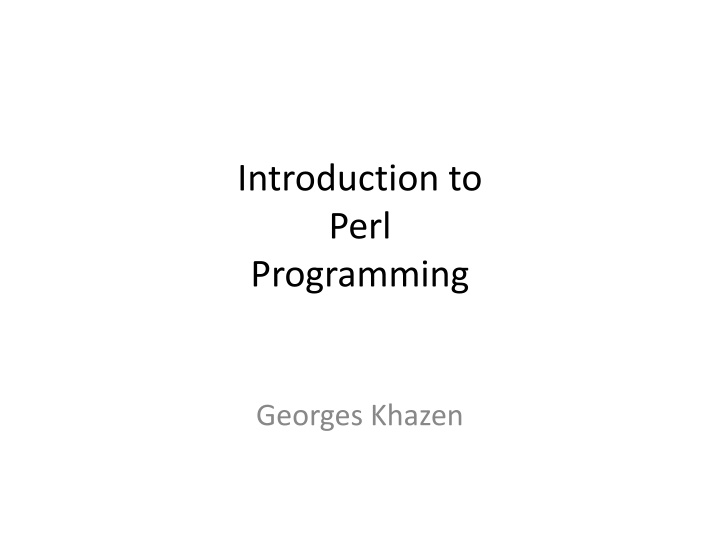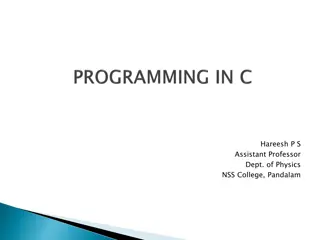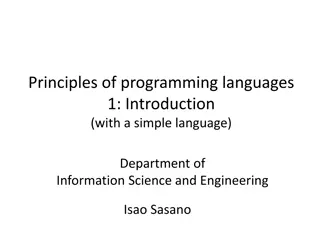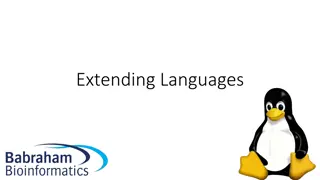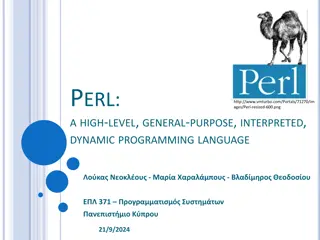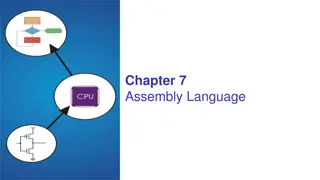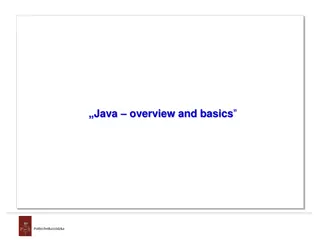Introduction to Perl Programming: A Versatile Language
Perl, a powerful and flexible general-purpose programming language, is known for its ability to act as a glue language in connecting various tasks. Learn about the origin of Perl, its installations, versions, and where to access it for free. Explore its rich documentation resources for efficient programming.
Download Presentation

Please find below an Image/Link to download the presentation.
The content on the website is provided AS IS for your information and personal use only. It may not be sold, licensed, or shared on other websites without obtaining consent from the author.If you encounter any issues during the download, it is possible that the publisher has removed the file from their server.
You are allowed to download the files provided on this website for personal or commercial use, subject to the condition that they are used lawfully. All files are the property of their respective owners.
The content on the website is provided AS IS for your information and personal use only. It may not be sold, licensed, or shared on other websites without obtaining consent from the author.
E N D
Presentation Transcript
Introduction to Perl Programming Georges Khazen
What is Perl? Perl is a general-purpose programming language, and can be used for practically any programming task any other high-level language can be used for. However, Perl is usually thought of as a glue language, so called because it binds things together (such as tying databases to Web pages, converting files from one format to another, and so on). Perl is very flexible and is currently available on over two dozen operating system platforms
Perl Perl stands for Practical Extraction and Report Language . Many of its features are borrowed from other programming languages. The Perl system uses an interpreter, called perl . Usually Perl and perl are considered to be the same thing for practical purposes.
Versions of Perl The current versions of Perl are all in the 5.X and 6.X series. If you have an older version of Perl (such as Perl 4.X), you should upgrade it as many changes were made between releases. Perl 4.X was a very buggy release of Perl and should not be used. Also, many Perl programs designed for 5.X will not work with 4.X.
Maybe Perl is already installed Many operating systems come with Perl installed. You can easily check whether Perl is loaded on your system by issuing the command: perl v If you get a version number, Perl is installed. If you get an error message about command not found (or something similar), Perl is not installed.
Where to get Perl Perl is free There are several releases, so make sure you get a current release. For Linux or UNIX systems, visit perl.com for the latest releases For Windows systems, you can compile the Perl source code yourself (a hassle) or download a preconfigured Windows release at activestate.com For Macintosh, visit macperl.com for MacPerl
Perl documentation Every release of Perl comes with documentation in a set of files. Most releases have over 1,700 pages of documentation included in reference books, user guides, FAQs, and so on. On most operating systems, a utility called perldoc is installed as part of the Perl system. The perldoc utility can search for and format Perl documentation for you. To use perldoc to look up the basic syntax for perl, open a terminal or console and issue the command: perldoc perl
More on perldoc The Perl documentation is divided into parts by purpose: perlfunc (Perl functions) perlfaq (Perl FAQs) perlop (Perl operators) To search for a particular keyword, use the tf options. For example to look up the print keyword: perldoc tf print To search the FAQs use q as an option: perldoc q free
What you need When you have installed Perl on your system, all you need to use the language is a text editor that can save ASCII files. All Perl scripts are written and saved in ASCII characters. On some operating systems that do not have a Perl GUI front end, you will need to use a console or terminal window to interact with Perl. Some GUI- based Perl front ends are available for Linux, UNIX, Macintosh and Windows.
Comments in Perl All comments in Perl are written starting with a # sign. Anything after the # sign through to the end of the line is ignored by the interpreter. Comments can be placed anywhere on the line, but commands cannot follow a comment on the same line Multiline comments should have a # symbol as the first character on every line
The #! directive The sole exception to # indicating a comment is on the first line of a Perl program (or script ). All Perl programs can begin with the line: #!/usr/bin/perl The #! is a hold-over from UNIX that instructs the operating system to use the /usr/bin/perl program to run whatever is in this file The path may be different for your system, and many environments such as Windows do not need this line. However, it will not cause errors.
Semicolons All valid Perl command lines end in semicolons. Without a semicolon, As opposed to shell, Perl continues to read onto the next line and doesn t assume a carriage-return is the end of a statement. You can break Perl commands over multiple lines because of this, as long as a semicolon is the end character in the complete statement. Perl uses semicolons in the same way as C/C++ and Java
Whitespace Whitespace is ignored by the Perl intepreter. You can use whitespace (spaces and tabs) anywhere in your programs to make them more readable. You should use whitespace to help format your scripts to show loops, logic layout, and continuation of statements, as you will see later in this course
The print command The print function tells Perl to display whatever follows, such as a string, variable name, and so on. You ll see how to build complex print statements later. The print statement allows the C or Java escape characters to be used for line feeds, backspace, tabs, and so on. For example, the command: print Hello\n ; will print Hello followed by a newline.
A Hello World script We can write a simple Perl script for the traditional Hello World application: #!/usr/bin/perl print Hello World!\n ; These two lines can be saved in a file as ASCII and then run by perl by issuing the command: perl filename
Scalars Scalars are the Perl term for basic units, including strings and numbers of different forms, as well as constants (which are often called literals ) There are several types of data supported by Perl, and you will see most of them in this and the next module
Numeric Scalar Variables Perl uses the dollar sign to indicate scalar variables, followed by the name of the variable. For example: $date is a variable called date . The dollar sign is a type identifier that tells Perl this is scalar. Arrays use a different identifier, as you will see later. Variable names are case sensitive, so $Date and $date are different variables
Strings String types in Perl are like those in other programming language. Strings are treated literally when enclosed in quotation marks (either single or double). Escape sequences can be used with Perl strings. These are the most common: \n newline \r carriage return \t tab \b backspace
Special escape sequences Some escape sequences for strings have special meaning to Perl: \l change next character to lower case \u change next character to upper case \ literal single quotation mark \ literal double quotation mark \\ backslash
The q and qq operators Perl allows you to use these structures: q( ) qq( ) Instead of single and double quotes, respectively. So, qq(This is a test) is the same as This is a test These can be handy when embedding marks that would otherwise need escaping: qq(He said Help! then Now! )
Single and double quotes Double quotation marks allow expansion of variables within them. Single quotes do not. For example: This is from $name1 ; is not the same as This is from $name1 ; as the second will literally display $name1 which the first will substituted the value in the variable name1.
Declaring variables Unlike many programming languages, variables do not need to be declared prior to use with Perl. When the variable is assigned an initial value, Perl can figure out the data type. If you try to use an uninitalized variable, Perl will use the value zero for a numeric, or Null for a string. Avoid uninitialized variables as much as possible, as results can be unpredictable.
Assigning values Variables are assigned values using the equal sign: $string1= This is a test ; $var1=6; $var2=3.14159; You can assign operation results, as you would expect: $var3=$var2 + $var1;
The $_ variable The $_ variable is used by Perl as a default variable. You can use it in place of variable names in your scripts: $_= This is a test ; print; This will print the default variable $_ and display the string. Use the default operator carefully as it can easily be confusing, but some operators and functions work best with default variables, as you will see later in this course.
Standard operators Perl supports the standard mathematical operators +, -, *, /, % (modulus) and ** (exponent) Operator order of precedence applies according to standard rules; parentheses group operations Operators can be combined in statements: $num1=$num2 * ((3 + 8)*$num3/2); Multiple assignments can be made on one line: $num1=$num2=$num3=7;
Exercise Write a program that simulates rolling five dice. Assign values between 1 and 6 to five different variables and display all five on the screen as well as the sum of the five numbers. Later you ll see how to use random numbers, but for now just assign the values. If you want to display a string and a variable together in a print statement, separate them with periods: print The sum is . $sum; You ll see this in the next few slides.
Positive and negative Numbers are assumed to be positive unless you specify a negative sign in front: $num1=6; # positive $num2=-6; # negative $num3=-(-6); # positive You can convert positive to negative any time using the minus sign in front of the variable: $num4=-$num4;
Increment and decrement Like C/C++ and Java, Perl supports autoincrement and autodecrement operators, which increase or decrease a value by one: $var1++; is the same as $var1=$var1+1; and $var2--; is the same as $var2=$var2-1;
Shortform assignment As with autoincrement and autodecrement, Perl supports shortform assignments like this: $var1+=5; which is the same as $var1=$var1 + 5; This can be performed for all four basic mathematical operators.
Operators and strings Strings can be used with the . operator for concatenation: $str1= Hello ; $str2= World! ; $str3=$str1 . $str2; print $str3; would print Hello World! You can also concatenate on output in most cases by specifying the string variables together: print $str1 . $str2;
The x operator The repetition operator, x, is used with strings to indicate a number of repeats for a string. For example, the code: $str1= x x 20; will string 20 x s together and assign them to $str1. You can use the repetition operator with existing strings: $str1= x ; $str2=$str1 x 20;
Other operators Perl supports several other operators: int: returns the integer portion cos: cosine sin: sine rand: random number between 0 and argument length: length of argument lc: converts to lowercase uc: converts to uppercase
Exercise Rewrite the last program to randomly assign a number to each of the five dice. To use rand, you need to specify the upper limit: rand(5) will generate a number between zero and 5. Remember all random numbers have a lower limit of zero. Have the program roll five dice and display results between 1 and 6, as well as the sum of the dice.
Converting strings to numbers Perl is flexible when using string types as numbers, as long as the conversion makes sense. For example, this works: $str1= 6 ; $num1=10-$str1; print $num1; will display the value 4. Perl can convert the string to a number if the string looks like a number. This applies to decimal strings as well.
Converting numbers to strings Perl can also convert numbers to strings when the conversion makes sense: $num1=3; $str1= I did it . $num1 . times ; print $str1; will display the message I did it 3 times. If the conversion doesn t make sense to Perl, it will use a zero instead when you try to call the number.
Code blocks Perl statements can be grouped together into blocks, each block surrounded by braces (like with Java) Code blocks can be nested many deep Each code block is treated as a unit by Perl, although execution is still always top to bottom unless moderated by control structures Usually blocks will be associated with other statements, such as if conditions
Exercise Modify the last program to display strings explaining that you are going to throw the five dice, generate five numbers, show them one at a time like this: The first dice was X. The second dice was Y. and so on, and display the sum on a separate line.
